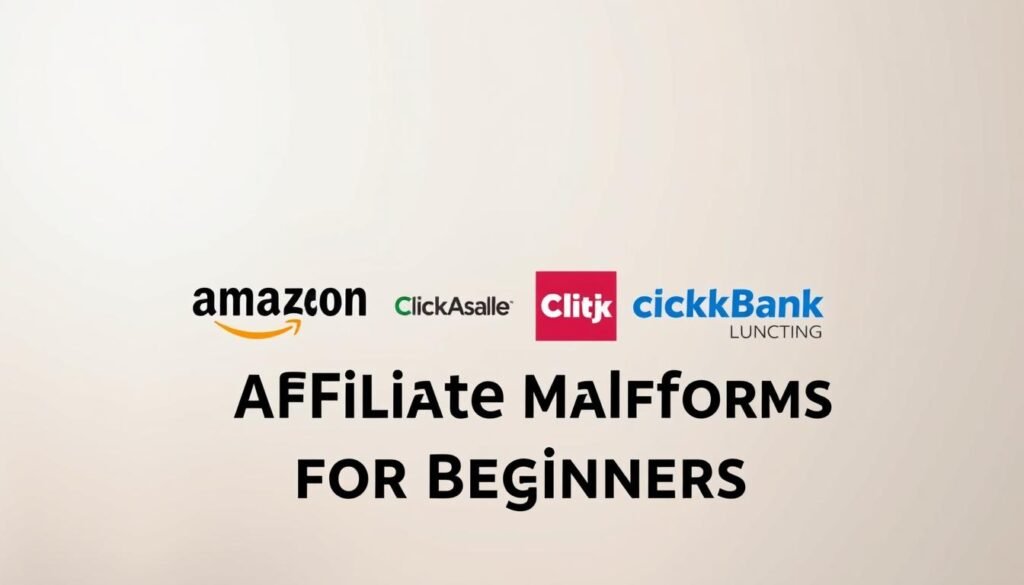Ever wondered how some people earn money while they sleep? The answer lies in a booming industry valued at $9.56 billion—and it’s growing fast. By 2025, experts predict it will reach $12 billion.
This flexible opportunity lets you promote products and earn commissions. No need for inventory or upfront costs. Real success stories, like Pat Flynn making $170k monthly, prove it works.
This affiliate marketing for beginners guide covers everything—from picking the right niche to building an audience. Whether you want extra income or to replace your 9-to-5, the potential is real.
What Is Affiliate Marketing?
Imagine getting paid just for recommending products you love. That’s the core idea behind this performance-based model. Brands partner with promoters who drive sales through unique tracking links.
Definition and Basic Concept
At its heart, it’s a revenue-sharing system. Three main players make it work:
- Merchants (sellers offering products)
- Publishers (promoters using blogs or social media)
- Consumers (buyers clicking affiliate links)
Promoters earn a cut—usually 5% to 30%—for every completed sale. Unlike traditional ads, payment happens only when results are delivered.
How It Differs from Traditional Marketing
Traditional ads charge for impressions or clicks regardless of outcomes. Here, brands pay solely for conversions. This lowers risk for sellers while rewarding effective promoters.
Tracking happens through cookies. For example:
- Amazon tracks clicks for 24 hours
- Outdoor retailer REI uses 15-day cookies
Take fitness influencer @caullenfit. By sharing MVMT watch links, they earn when followers buy. Transparency matters—the FTC requires clear disclosures about these partnerships.
Over 80% of e-commerce brands now use these programs. Why? It’s a win-win: businesses expand reach while creators monetize their influence.
How Affiliate Marketing Works
Three players make this income model thrive. Each has a unique role in driving sales and earning commissions. Let’s break down the process step by step.

The Three Key Parties Involved
Merchants create products or services. Examples include Shopify stores or brands like MVMT. They set commission rates, often between 5% and 30%.
Publishers promote these products. Bloggers, YouTubers, or social media influencers fall here. They share unique tracking links to earn a cut.
Consumers complete the cycle. When they buy through an affiliate link, the publisher gets paid. No extra cost to the buyer.
Types of Affiliate Marketing
Not all promotions are the same. Strategies vary by trust level:
- Unattached: Generic ads (e.g., PPC campaigns). No personal connection.
- Related: Niche-aligned content. A tech blog promoting gadgets.
- Involved: Personal endorsements. “@caullenfit” sharing MVMT watches they use daily.
The Role of Affiliate Links and Cookies
Tracking happens through cookies. These tiny files remember clicks for days or weeks. For example:
- Amazon tracks purchases for 24 hours.
- SEMrush pays $200 per referral, tracked via links.
EPC (Earnings Per Click) helps evaluate a program’s profitability. Higher EPC means better payouts for your traffic.
Why Start Affiliate Marketing?
What if you could earn money while focusing on what you love? This model rewards you for sharing products you believe in—without the hassle of traditional jobs. Let’s explore the top reasons to begin.
Passive Income Potential
Earnings don’t stop when you do. Sean Ogle made $500 in 5 minutes promoting a digital product. Once content ranks or gains traction, commissions roll in 24/7.
Beginners often earn $10k–$100k yearly. Top performers scale to six figures by leveraging SEO and evergreen content.
Low Startup Costs
You need $0 upfront. Platforms like TikTok or Instagram let you start instantly. No inventory, shipping, or customer service—just your voice and a link.
65% of promoters use blogging, but social media works too. Tools like Shopify Email simplify audience engagement for free.
Flexibility and Work-from-Home Opportunities
Location freedom is real. Sean Ogle managed his business from Bangkok. Set your hours, ditch the commute, and focus on what matters.
Compare this to traditional jobs: no rigid schedules or boss demands. Your effort directly impacts your income.
How to Start Affiliate Marketing: A Step-by-Step Guide
Ready to turn your passion into profit? This step-by-step guide will show you how. Whether you prefer writing, videos, or social posts, these six actions lay the foundation for success.

Step 1: Decide on a Niche
Your niche is your specialized topic. Choose one that balances three factors:
- Profitability: Check Amazon Best Sellers or Google Trends
- Personal interest: You’ll create better content about topics you enjoy
- Competition: Use Ubersuggest to analyze search difficulty
Example: Ryan Robinson’s freelancing blog thrives because he combines expertise with high-demand topics.
Step 2: Choose Your Platform
Match your skills to the right format:
- Blog: Ideal for detailed tutorials (WordPress works best)
- YouTube: Requires 20k+ subscribers for Shopping program
- Social media: TikTok’s @taylerfit shows how short videos convert
Step 3: Find Relevant Programs
Vet programs before joining:
- Compare EPC (Earnings Per Click) on networks like CJ Affiliate
- Read terms—some brands exclude certain traffic sources
- Check payment thresholds and schedules
Step 4: Create Valuable Content
Quality content builds trust. Mix these formats:
- Product comparisons (like Wirecutter’s detailed reviews)
- “How-to” guides solving specific problems
- Personal testimonials showing real usage
Update old posts quarterly—Google rewards fresh content.
Step 5: Build and Engage Your Audience
Your audience is your asset. Grow it through:
- Email lists (convert 3x better than social media)
- Q&A sessions on Instagram Stories
- SEO optimization for long-term traffic
Engaged followers buy more. Reply to every comment for 72 hours.
Step 6: Follow FTC Regulations
Protect yourself legally:
- Use clear disclosures like “This post contains affiliate links”
- Place notices above the fold (before content)
- Avoid false claims—only endorse products you’ve tested
Example: It’s Always Autumn’s craft blog uses compliant banners.
Choosing the Right Affiliate Marketing Niche
Finding the perfect niche is like unlocking a treasure chest—it holds the key to long-term success. Your choice determines whether you attract the right audience and convert clicks into commissions. Let’s explore how to pick a niche that balances profit and passion.
Identifying Profitable Niches
Some niches consistently outperform others. Travel, pet care, and tiny homes saw surges in demand during COVID-19. For example, Biking Know How grew by focusing on cycling trends.
Use these tools to spot opportunities:
- Google Trends: Track rising search queries.
- Ahrefs: Analyze keyword difficulty and traffic potential.
Avoid oversaturated markets like generic tech reviews. Micro-niches (e.g., “eco-friendly pet toys”) often convert better.
Aligning Your Niche with Your Interests
Promote products you genuinely love. The True Crime Obsessed podcast thrived by blending passion with profit. Your enthusiasm translates into authentic recommendations.
Ask yourself:
- Would I use this product daily?
- Can I create content about it for years?
Assessing Competition and Demand
Rohan Kadam’s cycling site succeeded by targeting gaps in bike maintenance guides. Use SEMrush to spy on competitors’ top-performing pages.
Key metrics to check:
- Organic traffic volume.
- Backlink profiles.
Build trust by solving problems your audience cares about. The deeper the need, the higher the conversion rates.
Best Affiliate Marketing Platforms for Beginners
Not all programs are created equal—some pay better than others. The right platform maximizes your earnings while fitting your niche. Here’s a breakdown of top choices for new promoters.

Amazon Associates
Amazon’s affiliate program is ideal for beginners. It offers 1–4.5% commission, depending on the product category. The 24-hour cookie tracks purchases, but rates are lower than niche alternatives.
Pros:
- Easy approval process
- Millions of products to promote
Cons:
- Lower payouts vs. specialized brands like REI (5%+)
Shopify Affiliate Program
Shopify Affiliate Program rewards promoters with up to $2,000 per referral. You earn recurring revenue if the merchant stays active. Perfect for audiences interested in e-commerce tools.
Key perk: High-ticket payouts for minimal effort.
CJ Affiliate and ShareASale
These networks vet brands rigorously, ensuring reliable partnerships. CJ Affiliate works with giants like Overstock, while ShareASale excels in fashion and home goods.
Tip: Check EPC (Earnings Per Click) to compare programs.
Niche-Specific Programs
Specialized programs often pay more. GolfPad GPS offers 10–15% commission—triple Amazon’s rate. Use tools like Ahrefs to find high-converting niches.
Example: A fitness blog promoting protein powders at 20% per sale.
Creating Content That Converts
Great content is the backbone of any successful promotion strategy. It builds trust, drives traffic, and turns casual visitors into loyal buyers. Whether you write blogs or create videos, your goal is to provide value while guiding your audience toward the right links.
Product Reviews and Comparisons
Honest reviews work because they solve a problem. Readers want to know if a product fits their needs. Break down your review into clear sections:
- Pros and cons: List key benefits and drawbacks.
- Personal experience: Share how you used the item.
- Alternatives: Compare similar products.
Example: A detailed MVMT watch review highlighting battery life and style versatility outperforms generic descriptions.
How-To Guides and Tutorials
Step-by-step guides position you as an expert. They also rank well in search engines. Focus on specific problems your audience faces.
Popular tutorial formats include:
- “How to Start a Dropshipping Business in 2024”
- “Best Budget Camera Setup for Beginners”
Tools like Canva help create engaging visuals. BuzzSumo identifies trending topics to cover.
Leveraging Social Media and Email Lists
Social media platforms amplify your reach. @taylerfit’s fitness videos drive 460k TikTok followers to nutrition links. Key tactics:
- Instagram Stories with swipe-up actions
- Pinterest pins linking to blog reviews
Email lists convert 3x better than social posts. Offer exclusive discounts (e.g., “15% off via bio”) to grow your list faster.
| Content Type | Best Platform | Conversion Rate |
|---|---|---|
| Product Reviews | Blogs | 4.8% |
| Tutorials | YouTube | 3.2% |
| Social Posts | 1.9% |
Building an Audience for Affiliate Marketing
Your audience is the fuel that powers your success—here’s how to grow it. Whether through email lists or social media, engagement turns clicks into commissions. Focus on trust, and the sales will follow.
Growing Your Email List
Email converts 3x better than social media. Location Rebel Academy boosts sign-ups with quizzes like “What’s Your Dream Job?” Tools like ConvertKit offer 40% commissions for referrals.
Pro tips:
- Offer lead magnets (e.g., free checklists).
- Segment lists for targeted promotions.
Engaging on Social Media
Polls and Q&A sessions drive interaction. @BreakingEighty’s golf tips earn 20% higher engagement with weekly Instagram polls. Mediavine publishers hit $100k/year at 50k monthly views.
Best platforms:
- Instagram Stories for swipe-up links.
- Pinterest for evergreen blog traffic.
SEO Strategies for Organic Traffic
Long-tail keywords like “best budget golf rangefinder” attract qualified traffic. Breaking Eighty’s launch monitor reviews rank #1 with 2,000+ monthly visits. Collaborate with niche influencers for backlinks.
| Tool | Best For | Conversion Rate |
|---|---|---|
| ConvertKit | Email Automation | 5.2% |
| Interact | Quizzes | 4.8% |
| Canva | Social Graphics | 3.1% |
Remember: Quality content keeps your audience coming back. Update old posts and track traffic with Google Analytics.
Understanding Affiliate Marketing Commissions
Understanding how payouts work can significantly boost your income potential. Commissions vary widely—some programs pay per sale, while others reward leads. Let’s break down the models that determine how much money you can earn.
Pay-Per-Sale vs. Pay-Per-Lead
Pay-per-sale is the most common model. You earn a percentage (or flat rate) when a purchase happens. For example, Amazon pays 3% on electronics, while niche brands like REI offer 5%.
Pay-per-lead rewards actions like sign-ups. SEMrush pays $200 for each referred customer who buys their tool. Choose based on your audience’s buying habits.
Average Commission Rates
Rates depend on product types:
- Physical products: 5–20% (e.g., fitness gear, home goods)
- Digital products: 30–50% (e.g., software, courses)
- High-ticket items: Flat fees up to $500+ (e.g., SaaS tools)
Bluehost pays $65 per hosting sign-up—proof that flat rates can outperform percentages.
High-Ticket vs. Recurring Commissions
High-ticket sales mean bigger payouts. Promote a $1,000 course at 50%, and you earn $500 instantly. WP Engine’s lifetime hosting commissions show how recurring income builds long-term wealth.
Pro tip: After proving your conversion rates, negotiate higher commissions. Direct brands often offer better terms than networks.
Common Affiliate Marketing Mistakes to Avoid
Small missteps can cost you big in terms of credibility and earnings. Whether you’re new or experienced, sidestepping these errors ensures long-term success. Let’s dive into the top pitfalls and how to fix them.
Promoting Too Many Products
Overloading your site with unrelated products hurts credibility. For example, a fitness blog pushing kitchen gadgets confuses visitors. Focus on niche-relevant items like @caullenfit’s MVMT watches.
Risks of overpromotion:
- Diluted authority—your audience questions your expertise.
- Lower conversion rates—irrelevant ads get ignored.
Ignoring FTC Disclosure Rules
The FTC mandates clear disclosures for affiliate links. Fines can reach $50,000 per violation. Follow these rules:
- Place notices before content (e.g., “This post contains affiliate links”).
- Avoid vague phrasing like “sponsored by.”
Example: It’s Always Autumn uses banner disclaimers above blog reviews.
Neglecting Audience Trust
Trust is your most valuable asset. True Crime Obsessed’s curated picks thrive because they only endorse tested products. Rebuild credibility with:
- Honest reviews—highlight flaws alongside benefits.
- Quarterly audits—remove underperforming links.
Pro tip: Engage followers with polls to gauge their needs.
Tools and Resources for Affiliate Marketers
The right tools can turn effort into effortless earnings. From tracking clicks to crafting high-converting content, these platforms help you work smarter—not harder. Here’s a curated list of essential resources to scale your strategy.
Tracking and Analytics Tools
Data drives decisions. Use these platforms to measure performance:
- Google Analytics 4: Tracks traffic sources and user behavior.
- SEMrush: Analyzes keyword gaps and competitor backlinks.
- ClickMeter: Monitors link clicks and conversion paths.
For example, Ahrefs reveals which blog posts attract the most clicks—optimize those first.
Content Creation Tools
Quality content fuels conversions. Streamline production with:
- Canva: Designs eye-catching social media graphics.
- SurferSEO: Optimizes articles for search intent.
- Grammarly: Polishes writing for clarity and engagement.
Descript’s video-editing features help YouTubers trim silences automatically.
Affiliate Networks and Direct Programs
Choose platforms that align with your niche:
- ShareASale: Ideal for fashion and home goods promotions.
- Awin: Dominates European markets with localized offers.
- WP Engine: Pays $200 per referral for hosting sites.
| Tool | Best For | Pricing |
|---|---|---|
| SEMrush | Keyword Research | $119.95/month |
| Canva | Graphic Design | Free (Pro: $12.99/month) |
| ShareASale | Fashion Affiliates | Free to join |
Pair these tools with Termly for FTC-compliant disclosures. The right stack saves time and maximizes profits.
Success Stories: Real-Life Affiliate Marketing Examples
Success leaves clues—these real-world examples reveal the blueprint for affiliate earnings. Whether through blogs, Instagram, or YouTube, top performers combine authenticity with smart strategies. Let’s break down how they turned passion into profit.
Case Study 1: Blogging Success
The Wirecutter’s $30 million acquisition by The New York Times proves the power of detailed reviews. Their team tests every product, creating trust that converts 4.8% of visitors into buyers.
Freelance writer Ryan Robinson mirrors this approach. His niche-focused blog earns five figures monthly by recommending tools he actually uses. Key tactics:
- 200+ hour testing periods for accuracy
- Comparison tables highlighting value
- Quarterly updates to maintain rankings
Case Study 2: Social Media Influencers
Fitness coach @taylerfit built a 460k TikTok following by pairing workout clips with nutrition affiliate links. Her secret? Showing real meals using promoted blenders and supplements.
Similarly, @caullenfit’s MVMT watch promotions earn $3k monthly. Their social media strategy includes:
- 30-day wear tests before endorsements
- Side-by-side price comparisons
- Instagram Stories with swipe-up links
Case Study 3: YouTube Affiliates
Golf gear tutorials demonstrate YouTube’s earning potential. One creator monetizes launch monitor reviews with affiliate tags, generating $12k/month. Their formula:
- 15-minute tutorials solving specific problems
- Links to 3 budget-friendly options
- Annotations with discount codes
Biking Know How’s authenticity principle applies here—their “best commuter bikes” video drives 35% of total sales.
Key takeaway: Whether through written reviews or video demos, genuine expertise wins. Test products thoroughly, disclose partnerships transparently, and focus on solving problems—not just pushing links.
Conclusion
Now you have the roadmap to turn recommendations into revenue. This guide covered the essentials—from picking a niche to building trust with your audience. Remember, success starts with value, not just sales.
Begin with beginner-friendly programs like Amazon Associates. Focus on products you genuinely love. Over time, you can scale this into a full-time income.
Your next step? Download our free checklist to stay on track. It covers niche selection, content creation, and FTC rules—everything you need to start strong.
Ready to take action? The opportunity is yours.





